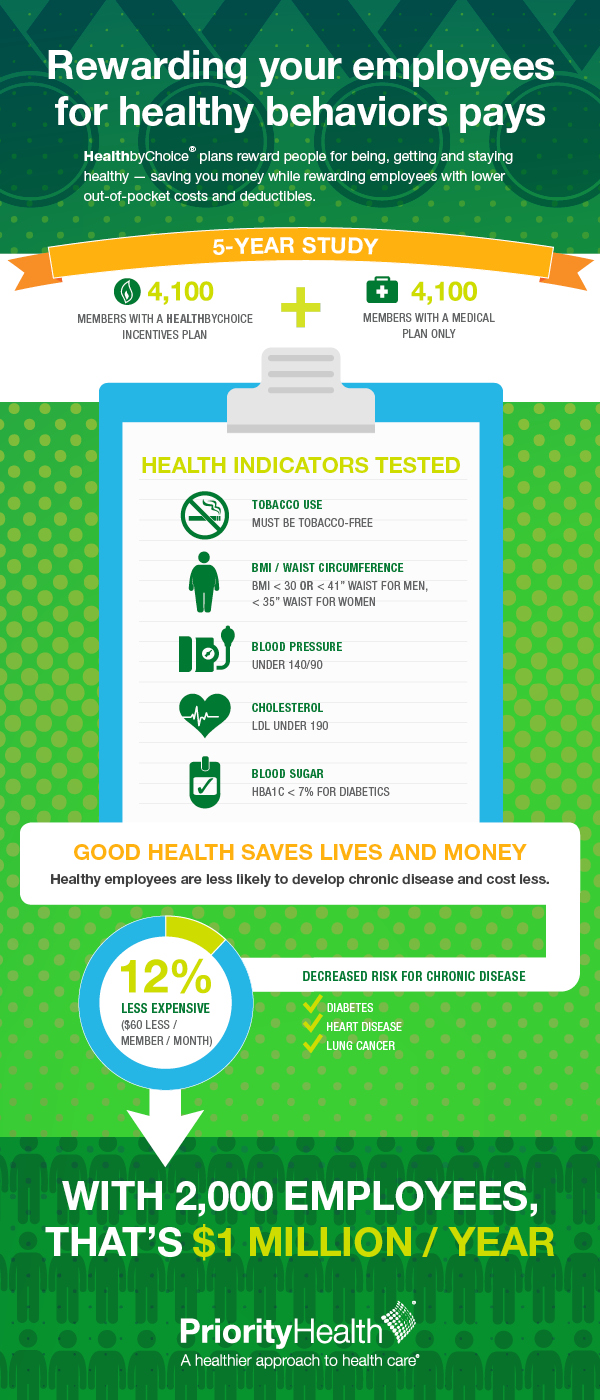Previously viewed as a courtesy rather than a necessity, organizations are now seeing the return and value of investing in their employee’s health.
Over the years, wellness programs have been tested and studied, and the results prove the investment is worth the effort. In a recent five-year study, Priority Health was able to prove that employers offering its HealthbyChoice® plans reduced medical expenses up to 12 percent in claims cost, or up to $60 per month per member. Not only saving employers money, but participating individuals developed chronic conditions at a slower rate compared to those in similar non-wellness plans.
Companies can use wellness programs to fight against their escalating health care costs, which are only rising with an aging workforce. Chronic diseases, such as diabetes and heart disease that generally stem from lifestyle habits, often lead to higher health care costs for employers, and can even lower employee productivity. Through wellness programs, these diseases can be managed and monitored to lower costs and better employee’s health.
But how do you properly engage workers to participate in wellness programs? Are your company offerings right for your employees?
Know the benefits.
Lower costs to employers is a huge benefit for adopting wellness programs, as proven by the recent HealthbyChoice study, but this is not the only benefit. By slowing the onset of chronic conditions and diseases, people stay healthier longer, miss fewer days of work and have greater work productivity. This value is passed on to the employee through lower copays and deductibles, improved overall health, and a daily, wellness-focused workplace environment. With proper long-term support, workplace wellness health plans can help reduce unhealthy behaviors that lead to chronic conditions and encourage sustainable, healthy lifestyles.

Communicate what is available.
If employees have desires to lose weight, reduce their blood pressure or stop smoking, they should know that the wellness program can help them achieve those health goals. Internal communication with employees about the wellness benefits of their plan is critical for engagement and participation. It should happen regularly and consistently to highlight areas of growth.
Most analyses of workplace wellness programs focus on hard-dollar returns – money invested versus money saved. Often overlooked is the potential to strengthen an organization’s culture and to build employee pride, trust, and commitment. And the increased value the company is able to provide to its employees by focusing on wellness and helping them achieve personal health goals is invaluable.
The inherent nature of workplace wellness—a partnership between employee and employer—requires trust. Because personal health is such an intimate issue, investment in wellness can, when executed appropriately, create deep bonds.
Health care is a monumental issue for employers, and too much is at stake to be reactive. It’s time for companies to play offense rather than defense. A verifiable payback isn’t certain, and the journey can be arduous, but what is the alternative?
Offer non-traditional wellness alternatives.
According to a study on Workplace Wellness Trends, conducted by the International Foundation of Employee Benefits Plans, non-traditional benefits are gaining employees’ attention and eventually becoming a bigger part of the workplace plan offerings. Increased vacation time, community service and engagement, fun entertainment activities, offering holistic services such as on-site yoga or massage, within the workplace and even financial counseling are emerging as popular non-traditional wellness components.
It is beneficial for HR leadership to analyze their company employees and figure out their wellness needs.



